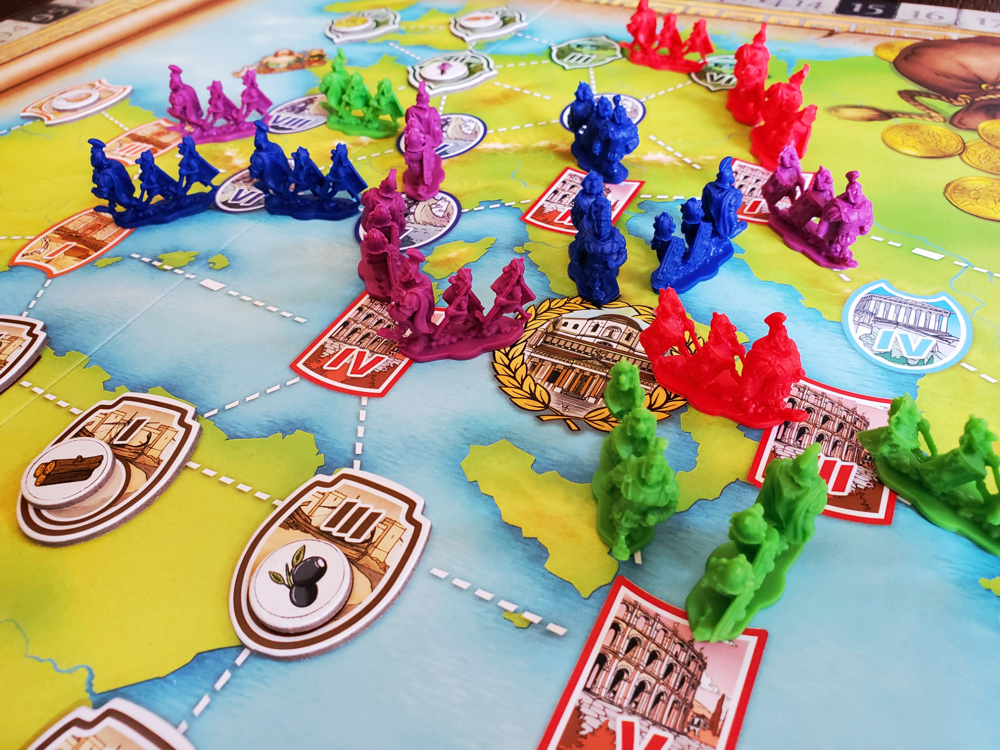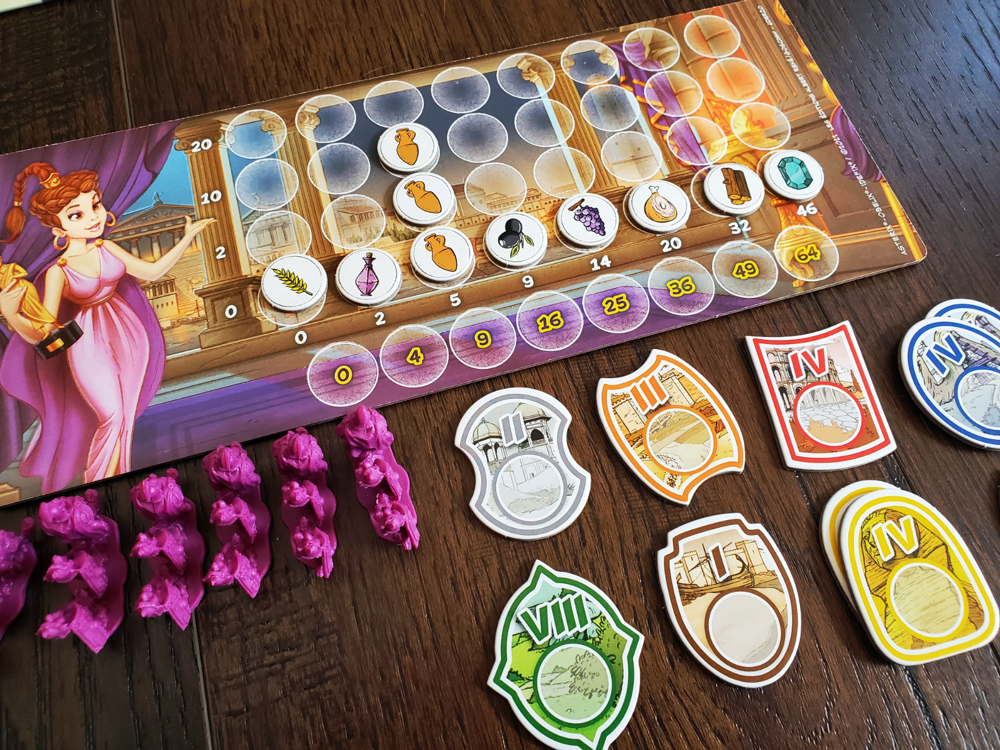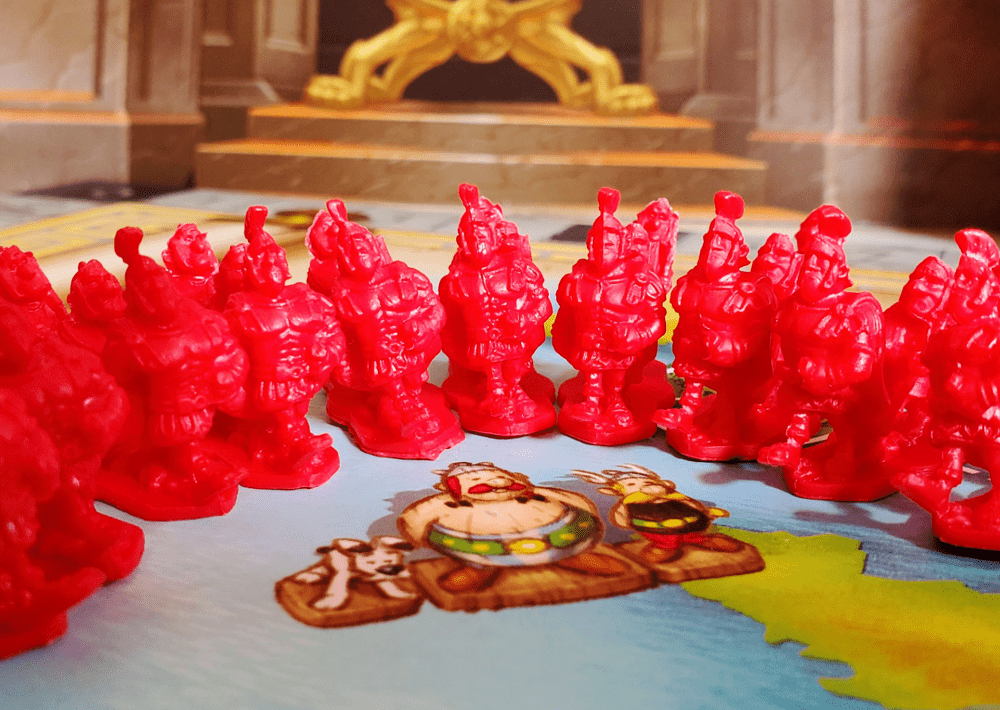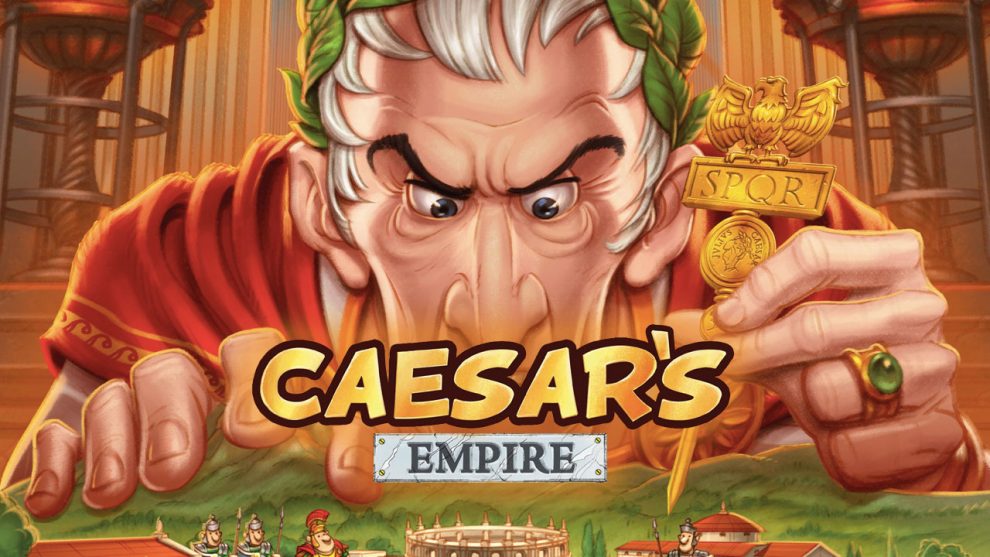Disclosure: Meeple Mountain received a free copy of this product in exchange for an honest, unbiased review. This review is not intended to be an endorsement.
Getafix
Ours is an Asterix household. Originally written as a comic in the 1960s, Asterix & Obelix is the ongoing saga of everyone’s favorite Gaul and his cronies as they stand firm against Julius Caesar and the expansion of Rome. Written by René Goscinny and illustrated by Albert Uderzo, Asterix is a beloved classic that has even seen numerous (occasionally embarrassing) iterations on screen that range from campy to downright strange.
If you’d like to take a moment to bust out a celebratory dance in anticipation of the forthcoming 2023 movie Asterix & Obelix: The Middle Kingdom, I’ll wait.

Caesar’s Empire, from Holy Grail Games, takes place in the Asterix universe. This charming route builder was designed by Matthieu Podevin, who has a busy 2022 planned with three separate titles slated for release (Titan, Tiles of the Arabian Nights). The illustrations by Alexandre Bonvalot and Joëlle Drans own all the authenticity of the original, but in a modernized style.
It was not difficult to sell me on this opportunity. However, is the game worthy of the universe it inhabits?
Vitalstatistix
Caesar’s Empire begins with a routed map of the expanding Roman territory, with Rome herself in the center. City tiles mark the targets through which legions will build roads. Each city also begins with a random treasure tile, indicating the spoils of the conquest. Players are equipped with a game board and 25 Road minis, which feature a 3D trio of soldiers marching in line. No dice. No cards. Truth be told, you’ll spend more time arranging your army of civil engineer soldiers than setting up the board.

A player turn consists of placing enough Road segments to add a city to the empire. Segments must either be connected directly to Rome or to another city which has already been claimed. The player then collects the new city tile and its treasure and scores the route.
City tiles are collected beside the player board for endgame scoring. Treasures are collected onto the player board into rows and columns which clearly lay out variety and quantity. The exception is the gold treasure which boasts its own scoring track.
The route is then scored by tracing the most direct path back to Rome, awarding one point to the owner of each Road segment passed along the way. Because different players may have connected cities along the route, every player could conceivably score a point or two on any given turn. If gold happens to be the collected treasure, the route is worth two points per Road segment.

Play continues clockwise until every city and treasure tile has been claimed. That’s it.
Route scoring escalates through the game as play extends farther from Rome, making each Road placement increasingly interesting. In the early turns, when two players each score one point, it hardly feels like a decision. Choosing a placement near the end when another player will receive eight or ten points in exchange for expanding a set of resources—this is the tension of Caesar’s Empire, and the aspect of the design that keeps all eyes on the board all the time.
The city tiles are divided into regions separated by color. Each of these tiles boasts a Roman numeral (with newfangled Arabic numerals on the back for those who aren’t into Roman subjugation) stating its value. At the end of the game, each player scores their highest obtained city tile from each colored zone.
Treasures are scored in rows and columns. Rows indicate the variety of treasures collected. Each row containing at least two different resources will score something. Collecting at least one of each of the game’s eight normal resources is extremely lucrative. Columns indicate the quantity of treasure collected. The more of a single resource collected, the higher the score for that column. Gold is scored on its track as well.
Finally, the player who used the fewest Road segments in the game receives ten points, a little bonus for efficiency—or laziness.

Cacofonix
Caesar’s Empire looks like a game that was made thirty years ago. The map and the Road segments are reminiscent of the 1993 version of Risk. The intellectual property is a comic series from more than fifty years ago. And yet, this game feels like something fresh and simple for the family. Somehow the folks at Holy Grail managed to package nostalgia in a tidy modern box.
The components are playful. The colors are bold and bright throughout. The city tiles are cut in the shapes of different shields to make the game a bit more colorblind friendly. I already mentioned the attention that is inevitably paid to setting up some formation of soldiered Road segments.
There is nothing new about a six-fold board, but everyone who has played for Caesar’s glory has recognized the fun details on this board. First and foremost, there is a shadow of Caesar himself looking down on the board as if he is standing above you, watching your every move. I was giddy when I first spotted it! The implements pictured around the outside are cleverly integrated into the scoring track, giving even the simple bits a ton of charm. Most importantly, Asterix, Obelix, and Dogmatix are hanging out on a wee raft at sea—a teaser to go with the online hint from Holy Grail that the beloved heroes may join this party through an expansion sometime soon.

The two-sided board has a fixed setup for the city tiles on each side depending on the number of players. The 2-3 player side uses two less color zones, while the 4-5 player side utilizes all eight. I was surprised that the city tiles are designed to play in the same locations each time. I could see randomizing them to add a little spice to the board, but I’m not necessarily itching to make that change. The Western side of the map is more lucrative overall in terms of city points, but the game cannot be won without a focus that ranges all over the map. I can get behind the design choices here.
There are two variations suggested for the low player counts that increase the strategy on the more accessible board. One suggests pulling the resource counts out of balance to create more worthwhile sets, opening the doors to more risky choices. The other suggests pushing for the collection of entire city zones for added bonuses.
The first few turns in the base setup are largely the same, but the randomized resource locations balance the chase and make each play just a little different. The location of the gold can especially alter strategic choices and make certain routes more interesting. It is always worthwhile to attempt to gain all eight resources, but depending on the initial layout, quantity can win out over variety with the right mix of gold. It is worth building long chains of Road segments for repeated scoring, but without tapping into the supply chain in a timely fashion, roads alone cannot win. Timing is everything in pleasing Rome.
Caesar’s Empire nails the 30-60 minute window without even breaking a sweat, allowing for plenty of laughter and banter at the table, of course. It is lighthearted and breezy. There are decisions to be made, but the consequences remain loose. Losing is no big deal—you can always set it up and go again!

Unfortunately, the Asterix & Obelix world is not fully realized, but I have high hopes if the Holy Grail rumor mill is true. Still, they chose the right world for this style of game, as their titular heroes are the epitome of deceptively light fun. The comics can please a child with light-hearted conflicts, but they can also pack a punch with Latin jokes and literary and historical references for those interested in paying attention. I think the gameplay here is a solid match.
Adults and kiddos alike have enjoyed Caesar’s Empire around our table. Our eight-year-old fully grasps the gameplay and strategy, yet the table full of adults also found a bit of fun inside. I would highly recommend grabbing your print copy of Asterix the Gaul and starting into the series again so that you’re ready should you ever find yourself seeking to vini, vidi and vici your way into Caesar’s good graces.
One year later…
Caesar’s Empire is a semi-regular favorite in the household, a highly accessible and breezy afternoon play with the kiddos. The route-laying is still quite satisfying. We’ve tried randomizing the various tiles on the board with great success, deviating from the numerical setup printed on the board for the sake of variety.. The board is fresh with every new play. The sad and unexpected closure of Holy Grail Games interrupted my hopes of seeing Asterix enter the fray via an official expansion, but I am hopeful that someone will gobble up the rights to the title to keep it in print. One year in I can say our family definitely enjoys this one and we would all offer an enthusiastic recommendation.












Add Comment